As autumn descends and the landscape begins to shift into hues of gold and brown, now is the perfect time to prepare for a burst of color in your garden come spring. Planting spring-flowering bulbs in the fall is a simple yet highly rewarding endeavor that can yield vibrant displays of tulips, daffodils, crocuses, and hyacinths. These cheerful blooms are often the first signs of life after winter, providing a welcome splash of color when few other plants are in flower.
By selecting appropriate bulb varieties and adequately preparing your garden, you can create a low-maintenance garden that offers year-after-year beauty. Whether you are a seasoned horticulturist or a novice gardener, understanding the fundamentals of bulb planting will help you achieve a flourishing spring garden filled with early-season vibrancy.
Choosing the Right Bulbs for Your Garden
The key to a stunning and enduring spring display lies in the careful selection of bulbs. When choosing which bulbs to plant, several factors should be considered to ensure they thrive in your specific climate. Many spring-flowering bulbs, including tulips and daffodils, require a chilling period to bloom effectively. In colder regions, such as Eastern Idaho, this winter chill provides the ideal conditions for bulb growth.
Soil type is another crucial consideration. Bulbs thrive in well-drained soil to avoid rot; if your garden consists of heavy clay, it may be beneficial to amend the soil with compost or to plant in raised beds to improve drainage. Additionally, think about the bloom times of the bulbs you select—early, mid, or late spring—to create a continuous flow of color throughout the blooming season.
The quality of the bulbs you choose is equally important. Select bulbs that are firm, sizable, and free from blemishes or mold. Generally, larger bulbs produce more vigorous plants and vibrant flowers. Consider the height and color of each variety to ensure they complement each other and fit harmoniously within your garden design.
Many gardeners opt for a mix of bulb varieties, combining tall, striking blooms like alliums with shorter, delicate flowers such as crocuses. It’s also essential to note that some bulbs, like tulips, may need to be replanted each year, whereas others, such as daffodils and crocuses, can naturalize and return each spring, multiplying over time. By carefully selecting bulbs suited to your garden’s conditions and your desired aesthetic, you’ll lay the groundwork for a beautiful spring display.
Preparing Your Garden for Bulb Planting
Proper preparation of the planting site is critical for successful bulb growth and ensures that the blooms are healthy and vibrant when spring arrives. Bulbs need a well-drained site to prevent rot, so it is advisable to choose a location that receives full sunlight for at least six hours a day. Avoid low-lying areas where water tends to accumulate, as bulbs do not flourish in excessively wet conditions.
To enhance drainage and soil quality, consider incorporating organic matter such as compost or well-rotted manure into the soil prior to planting. Loosening the soil to a depth of 12-14 inches will also help roots establish themselves more easily. If you are dealing with heavy clay soil, adding sand or grit can significantly improve drainage. For optimal results, test the soil’s pH, aiming for a neutral to slightly acidic environment, as most bulbs thrive in this range. With the right conditions established, your bulbs will have the best chance to flourish when spring arrives.
Proper Planting Techniques for Healthy Bulbs
To ensure strong root development and healthy blooms, planting bulbs correctly is essential. Begin by digging holes or trenches to a depth approximately three times the height of the bulb. This depth protects them from frost and provides sufficient space for root growth.
When spacing the bulbs, consider the variety—typically, bulbs should be planted 3 to 6 inches apart, depending on their size and the desired effect. For a more natural appearance, scatter bulbs in groups rather than planting them in straight rows. Always remember to place the bulbs with the pointed side facing up, as this is where the stem will emerge.
Once the bulbs are positioned in the soil, cover them gently with soil, lightly firming it down to eliminate air pockets. It is crucial to water the bulbs thoroughly after planting to help them settle and establish roots before the ground freezes.
Protecting Bulbs During Winter
To ensure the survival of your bulbs through harsh winter conditions and to guarantee a beautiful bloom in spring, protective measures are necessary. Once the bulbs have been planted, applying a layer of mulch after the ground freezes can help insulate the soil and prevent frost heaving. This phenomenon occurs when the ground repeatedly freezes and thaws, pushing bulbs toward the surface.
Organic mulch materials, such as straw, shredded leaves, or wood chips, are ideal for this purpose. A 2-4 inch layer should be applied over the planting area. In regions that experience heavy snowfall, the snow cover itself can serve as a natural insulator for the bulbs. Additionally, if you are concerned about rodents or other animals digging up the bulbs, consider placing wire mesh or chicken wire over the planting area to deter them. By taking these precautions, you can protect your bulbs from cold temperatures, pests, and other winter challenges, enhancing their chances of thriving when spring arrives.
Conclusion
Planting spring bulbs in the fall is a rewarding activity that promises vibrant blooms and color in your garden after a long winter. By selecting the right varieties, preparing your garden properly, and implementing effective planting and protective techniques, you can ensure a beautiful display that will bring joy to your landscape for years to come. With careful planning and attention to detail, your spring garden can be a breathtaking spectacle of color, a true testament to your gardening efforts.
Related topics:


